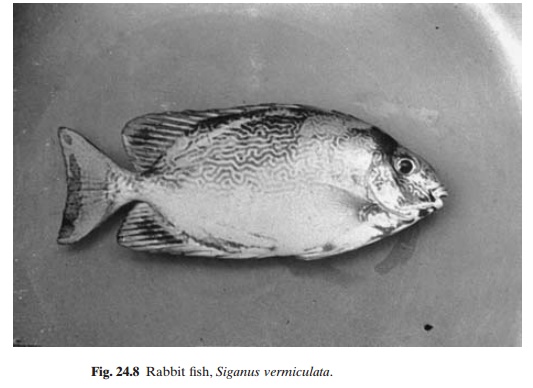Chapter: Aquaculture Principles and Practices: Other Finfishes
Grow-out of Rabbit fishes
Grow-out
Not much information is available on polyculture of siganids, nor do accounts of recent experimental or pilot-scale grow-out contain many data on stocking rates and growth performance. In coastal ponds in the Philippines, in monoculture or polyculture with milkfish, siganids, especially S. vermiculatus, are reported to attain a marketable size of 150 g within five to seven months. Similar growth is reported also for S. canaliculatus in coastal ponds. In tank culture in Israel, fry fed with algae (Ulva sp.) and 25 per cent protein commercial fish feed pellets showed a two-fold increase in length and a ten-fold increase in weight over five weeks. Similar growth rates are reported to have been achieved with S. canaliculatus in the Philippines, where they were fed on algae, and in Palau, with commercial chicken feed pellets.
Siganus rivulatus is reported to grow to aweight of 185 g in about 300 days in floating cages. Lichatowich et al. (1984b) reported a growth rate of 105 g in 150 days in floating cages, when this species was fed a mixture of soya meal (53 per cent), fish meal (14 per cent), maize (15 per cent), flour (15 per cent) and a vitamin-mineral mix (3 per cent) (from plastic trays suspended in the cages). The feeding rate was approximately 8 per cent of the biomass.
Observations in Palau show that S. canaliculatus cultured in floating pens grew faster in areaswith good water circulation, and when fed with trout chow instead of with algae only.
Though there is a ready market for siganids in most places, there are occasional reports of ciguatera poisoning as a result of eating them, especially in the South Pacific, and recently in Israel. The source of the ciguatoxin is believed to be marine algae such as Lyngbya majuscula, Plectonema terebrans and Schizothrix calciolla,which are eaten by the fish.

Related Topics